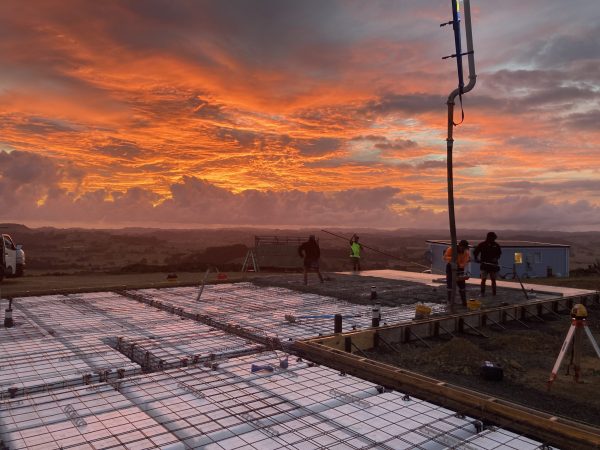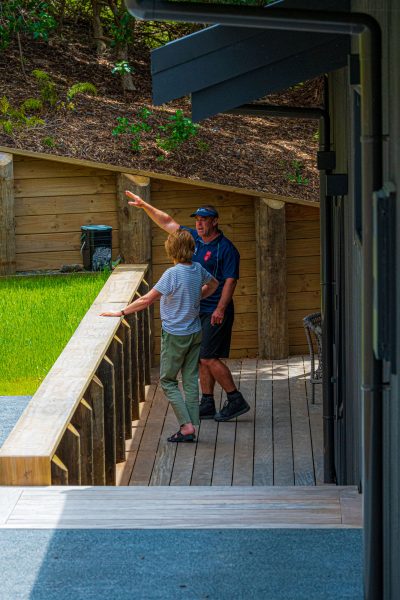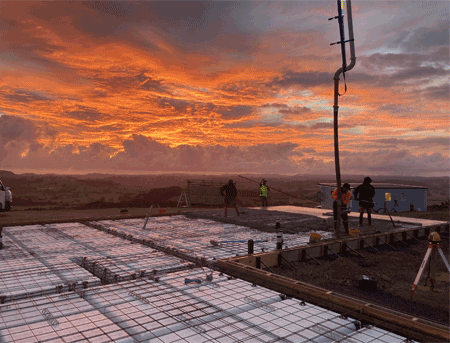Can You Lay Concrete in Winter?
 We often get asked whether it’s okay to do concrete laying in winter. While the South Island deals with frost and freezing conditions, here in Northland we have a bit more flexibility — but that doesn’t mean winter pours are straightforward. Cooler temperatures and wet weather bring their own set of challenges. The good news is, with the right planning and experience, concrete can still be laid successfully through the colder months.
We often get asked whether it’s okay to do concrete laying in winter. While the South Island deals with frost and freezing conditions, here in Northland we have a bit more flexibility — but that doesn’t mean winter pours are straightforward. Cooler temperatures and wet weather bring their own set of challenges. The good news is, with the right planning and experience, concrete can still be laid successfully through the colder months.
What Makes Winter Concreting Different?
Cold weather doesn’t mean you can’t pour — but it does change how we approach the job. Even in Northland’s milder climate, winter conditions affect how concrete behaves.
Slower Curing Times
Concrete relies on a chemical process called hydration to harden properly. When temperatures drop, this process slows down, meaning it takes longer for the concrete to gain strength.
More Moisture on Site
Winter brings damp ground, morning dew, and higher humidity. These conditions can affect everything from surface prep to finish quality.
Shorter Days
Less sunlight and cooler afternoons mean there’s a narrower window for pouring and finishing before conditions become less ideal.
How We Plan for Winter Concrete Laying
Laying concrete in winter takes more foresight. With the right preparation, we can avoid delays and ensure a strong, durable finish.
We Monitor the Forecast Closely
Timing matters. We look for clear breaks in the weather and avoid days where rain or cold snaps are expected. Even a few degrees can make a difference.
The Site Is Prepped Ahead of Time
We make sure formwork, sub-base, and access are ready to go well before the truck arrives. This avoids unnecessary delays that could expose the mix to poor conditions.
We Adjust the Mix if Needed
In colder conditions, we may:
- Use warm water to start the curing process
- Add set accelerators to help the concrete harden faster
- Modify the slump or mix design depending on the weather
Minimum Temperatures and When to Wait
Temperature plays a big role in whether a concrete pour should go ahead. While Northland doesn’t often dip into extreme lows, there are still days where it’s better to hold off.
What’s Considered Too Cold?
Concrete ideally needs the air and ground temperature to be above 10°C during placement and for several hours afterward. If it drops below 5°C, the curing process slows significantly — and if it freezes, it can cause long-term damage to the slab.
Daytime vs. Overnight Temperatures
We don’t just look at the high — we also consider how cold it will get overnight. A warm day followed by a sudden drop can affect early-stage curing and lead to surface issues or reduced strength. For larger pours like foundations or slabs, these temperature swings are especially important to plan around.
When We Recommend Delaying
If the forecast is borderline, we’ll wait. Rushing a pour under poor conditions can lead to cracking, surface scaling, and other avoidable problems. It’s better to reschedule than risk the integrity of your concrete.
Rain, Drainage and Surface Protection
Rain is one of the biggest factors we plan around during winter concreting. Even a light shower at the wrong time can compromise a pour if we’re not prepared.
Working Around Wet Weather
We keep a close eye on the forecast and often set up:
- Temporary shelters or tarps to protect the area during and after pouring
- Drainage channels to prevent water pooling around the slab
This is particularly important for exposed pours like footpaths and patios, where surface washout or uneven drying can affect the finish.
Protecting the Sub-Base
If the ground is too wet or soft, it won’t provide proper support. We make sure the sub-base is dry, compacted, and stable before any concrete is placed.
Curing Under Cover
Once poured, concrete needs protection while it sets. We may use:
- Plastic sheeting or curing blankets to keep moisture in and cold air out
- Wind barriers if conditions are gusty and could dry the surface too fast
Why Experience Matters More in Winter
Pouring concrete in winter isn’t just about following a checklist – it takes judgment, timing, and a good understanding of local conditions. That’s where experience makes all the difference.
Knowing When to Go Ahead – and When to Wait
Not every jobsite is the same, and sometimes the weather can change quickly. We rely on experience to read the conditions and make the right call for your pour, even if it means holding off for a better day.
Understanding Northland Conditions
We know what winter looks like here — when rain tends to fall, how the ground behaves, and what local temperatures actually mean on site. That local knowledge allows us to plan smarter and work more efficiently.
Confidence Through Communication
We’ll always be upfront about what’s realistic in winter. If the weather poses a risk, we’ll explain why and talk through the options. Our goal is to get it done properly, not just quickly.
Planning a Project This Winter? Talk to Us First
Concrete laying can absolutely be done in winter — it just needs a bit more planning. At Coastal Concrete Solutions, we take the time to get it right. If you’re looking to pour a driveway, patio, slab, or foundation during the colder months, talk to us early so we can schedule around the weather and ensure the best result.
We’re always happy to advise on timing, prep work, and whether it’s safe to proceed. Get in touch today and let’s talk about how to make your winter project a success.







